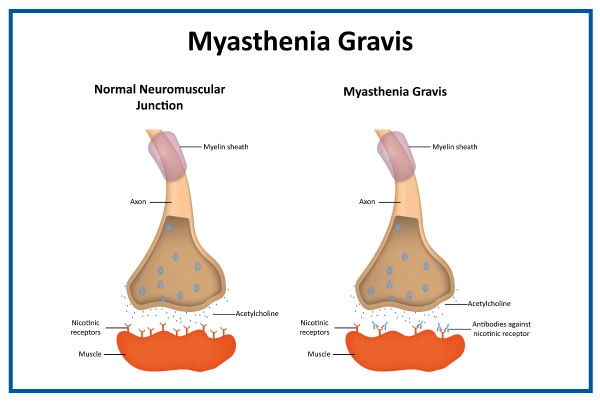What is Myasthenia Gravis?
Myasthenia Gravis (MG) is an autoimmune condition that causes signal transmission issues at the neuromuscular junction. As a result, the muscles get fatigue fast and improve after taking rest.
It mostly affects the muscles that regulate eye movements, facial expressions, chewing, and swallowing in the early stages. As the condition worsens, the neck and limb muscles may be affected, making it difficult to hold the head up, walk upstairs, and raise the arms. Breathlessness may occur if left untreated.
Although this condition does not run in families, those who develop autoimmune conditions are more likely to develop myasthenia gravis.

Symptoms
Initially patients may notice drooping of eyelids and impaired or double vision. Patients may present with difficulty in swallowing and chewing . Generalised weakness usually develops in first 2 years of illness. Myasthenia gravis symptoms, in general, include:
- Trouble holding up your head
- Drooping eyelids
- Eye muscles weakness
- Change in your facial expression
- Double vision
- Shortness of breath
- Trouble swallowing
- Problems walking and lifting things
- Speech problems
In severe MG conditions the respiratory muscles become so weak that one can't control them. This is a medical emergency that requires the use of a ventilator to assist patients in breathing. Around 15% to 20% of people with myasthenia gravis will have at least one myasthenic crisis. It can be caused by an infection, stress, surgery, or a medical reaction.
Causes
Here are some factors that contribute to the development of MG:
- Autoimmune response : Myasthenia gravis is primarily an autoimmune disease, meaning the immune system mistakenly attacks and damages the body's tissues. The immune system releases antibodies that target and block acetylcholine receptors at the neuromuscular junction. Acetylcholine is a neurotransmitter responsible for transmitting signals between nerve cells and muscles, and blocking these receptors disrupts muscle function.
- Genetic factors : While myasthenia gravis is not directly inherited, there is a genetic component to the disease. Some people may have a genetic predisposition that makes them more susceptible to developing the condition.
- Thymus involvement : The thymus gland, part of the immune system, plays a role in developing myasthenia gravis. Sometimes, the thymus gland is abnormally large (thymic hyperplasia) or contains tumors (thymomas) that trigger or exacerbate the autoimmune response. Surgical removal of the thymus (thymectomy) is a standard treatment for myasthenia gravis in cases where the gland is involved.
- Environmental factors : Certain environmental factors or infections may trigger the onset of myasthenia gravis in individuals genetically predisposed to the condition. However, specific triggers have not been definitively identified.
Risk Factors
Muscular dystrophy is a hereditary disease. A family history of muscular dystrophy puts you at risk of being a carrier or getting the disease.
- Smoking and tobacco chewing
- Physical inactivity
- Obesity
- Insufficient diet including lower rate of fish consumption.
